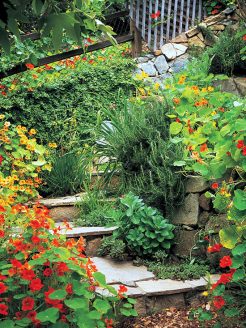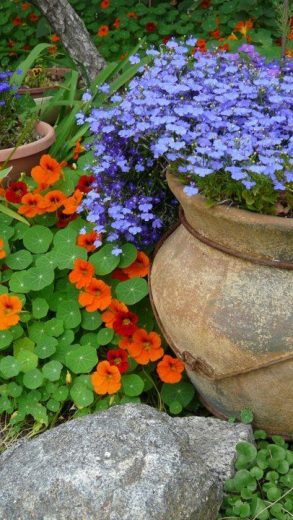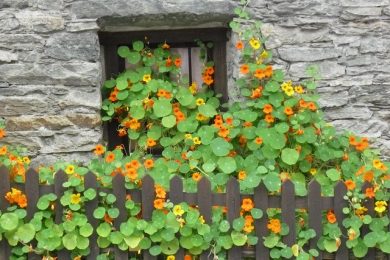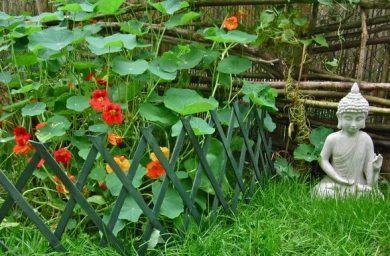Among amateur gardeners, nasturtium is a very popular flower. Moreover, it not only grows, but also blooms on rather poor soil, but on rich organic matter - on the contrary: green mass develops to the detriment of flower formation. In general, planting and caring for nasturtium is a rather fascinating process.
Material Content:
Culture Description
Nasturtium, or capuchin, is a representative of the genus of herbaceous plants, in which there are more than 90 species. The plant belongs to the Nasturtian family, and its homeland is considered to be South and Central America. But despite this, it has long been growing in temperate latitudes, feeling excellent.
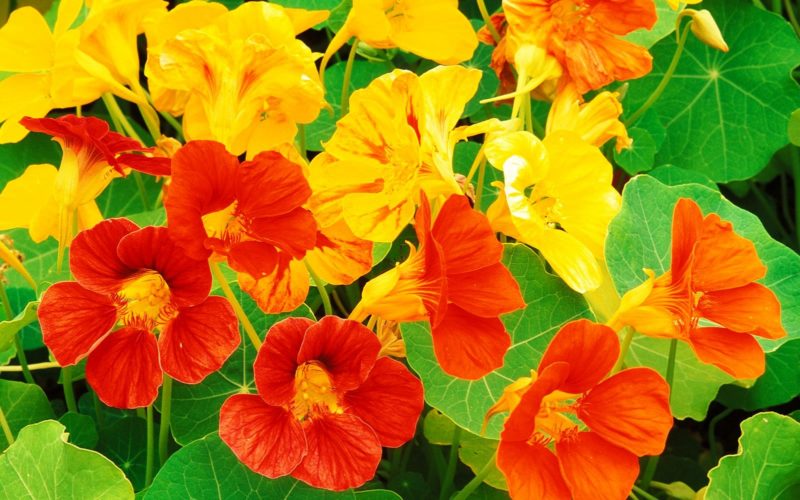
Nasturtium was brought to Europe from India, so the inhabitants of European countries called it "Indian watercress." When the flower was brought to Russia from Holland, he became the owner of the name "capuchin". The reason for this name was its shape, resembling the hood of the monks from the order of the Capuchins. Today, a culture filled with grace can be very often found in park areas, front gardens and even on window sills.
When to plant nasturtium in open ground
When growing nasturtium from seeds, two methods are used: seedling and seedling.
In the case of a seedlingless cultivation method, it is necessary to prepare a shallow planting pit of 2 cm, in which then it is necessary to place up to three seeds, maintaining the interval between holes of 20-30 cm.The optimal term for sowing in open ground is considered to be the end of May.Since the frosts characteristic of the beginning of the month can provoke the death of crop seedlings.
In areas where there is a high probability of return frosts, it is impossible to rush to plant crops in open ground. But in order to accelerate the emergence of seedlings and the onset of the flowering phase, you can resort to such a trick: moisten the soil with water at a temperature of +40 to + 50 ° C before sowing seeds. In the daytime, cover the areas where the crops were sown with a non-woven material, and at night cover with polyethylene. Watering should be carried out moderate and exclusively at room temperature. The final disclosure of young specimens is usually carried out in the first half of June.
In the case of the seedling method, the seedlings are planted in the front garden after the frost stops. In some areas, this may even be the first half of June. The variety affects the interval between specimens, which varies from 20 to 40 cm. According to experts, in case of the expected decrease in temperature to the complete rooting of the planted seedlings, cover material should be used at night. The flowering period of nasturtium begins after 1-1.5 months and lasts until the first frost.
Agrotechnical requirements for growing
Many experienced gardeners are aware of the unpretentiousness of capuchin to growing conditions. But despite this, if the goal is to get lush flowering, then you need to take care to comply with several simple requirements.
The soil
The best option for growing a representative of nasturtium will be light and moderately fertile soils with a high-quality drainage system. The decision to grow capuchin in a site rich in organic matter will not lead to the achievement of such a goal as rapid flowering. This is primarily due to the fact that in such a situation, due to the abundance of organic fertilizers, only excellent shoots will be formed in the plant.
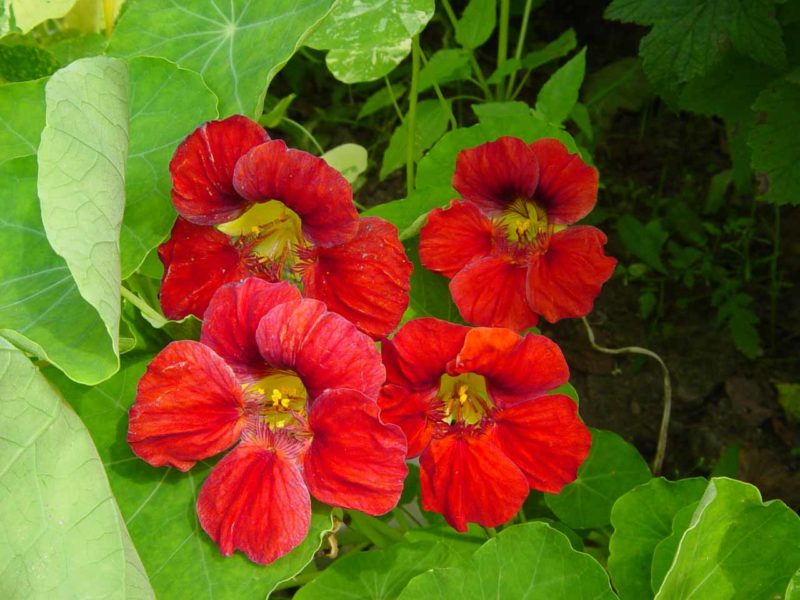
Choosing a place where the soil is mostly infertile will also not be a good solution. In poor soil conditions, almost the entire season, the stems will be bare, forming only small leaves. And an attempt to grow a culture on hard soil will not succeed: it will be affected by various diseases, which often leads to its complete death.
Lighting and windiness

Taking into account that nasturtium is a warm and photophilous culture, optimal conditions for its growth can be created only in areas where access to sunlight is open. Planting capuchin in a semi-shaded area will bring nothing but strong stems and thick green foliage throughout the season. When choosing a place, it is also worth considering that drafts harm him. Therefore, the area where this flower will grow should be calm.
Capuchin Care Rules
In order to create appropriate conditions for the proper growth of capuchin, not only planting, but also care should be carried out in compliance with specific rules.
Watering and weeding
Nasturtium is in dire need of watering and systematic weeding.
- Watering - the peak of the need for flowers in water falls on the phase of intensive growth: at its completion, the culture begins to bloom. The timing of irrigation depends on the state of the upper soil layer. But do not forget that you can’t water the capuchin too often: waterlogging of the soil causes the formation of pale inflorescences.
- Weeding - the main goals of this procedure are to reduce moisture evaporation and improve air circulation. In the absence of free time, you can mulch the soil in the root zone of the plant, which will reduce the number of weeds.
Flower pruning
In order to maintain the attractiveness of nasturtium over a long period, it is necessary to prune wilted flowers.The benefits of the providence of the procedure will find expression in the extension of flowering periods: timely pruning triggers the formation of new inflorescences.
Protection against diseases and pests
Nasturtium is a flower that has not only aesthetic beauty, but also beneficial properties. In addition, it scares away pests such as the Colorado potato beetle, whitefly, aphid, cabbage, from itself and from planting other plants nearby.
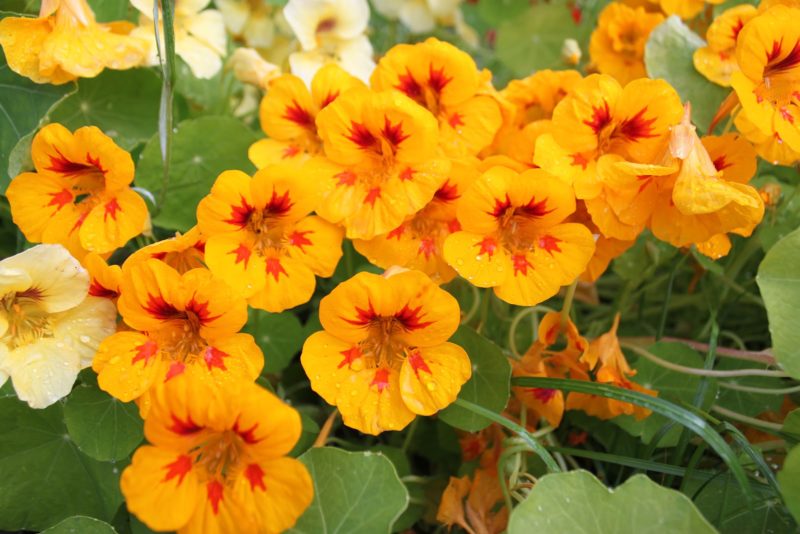
But capuchin is susceptible to diseases:
- Bacterial wilting - the disease manifests itself by weakening the lower leaves, and then complete wilting of the flower.
- Gray rot - a distinctive feature is the formation of dry brown spots on the leaves.
- Rust - the result of this disease is the appearance of a small brown or black spot on the plant.
- Mosaic is another type of spotting that harms the attractiveness of a flower.
In the case of the above manifestations, the affected specimens should be eliminated and fungicides treated healthy plants.
Seed collection
If, after the pleasure of blooming beauty, the desire arose to acquire flower seeds, you only need to choose the right moment for this. In the case when the grower has the ability to constantly monitor the seeds of flowers, this is easiest to do. Noting that they begin to ripen and have already acquired a whitish hue, you can start collecting. However, it should be borne in mind that this procedure is carried out before they fall, otherwise there will be an independent propagation of capuchin in places that were not intended for this.
When growing curly nasturtium, it must be taken into account that, unlike other varieties, the seeds in this species do not reach full ripening.
Care after flowering
After flowering is completed, watering is gradually reduced to a complete cessation. And in connection with the fact that this flower is grown mainly as an annual crop, then care for it with the advent of autumn must be carried out the same as for an annual: to collect and burn the tops, dig the site.
Propagation of nasturtium
Amazing capuchin is known both for its decorative effect and healing properties, as well as excellent taste. Thanks to this, he won a place of honor in medicine, cooking, landscape design, and this, in turn, led to the fact that not only experienced flower growers are engaged in the cultivation of this flower.
Seed propagation

This unique plant is propagated using seeds in two ways:
- Reckless method - before sowing capucin seeds for 20 minutes should be placed in a container of hot water at a temperature of +40 to + 50 ° C, and then soaked for a day. Growing capuchin by the non-seedling method has its advantages: growing plants in a permanent place makes it possible to prevent their disease, which often happens with seedlings. However, there is a minus: the culture blooms later.
- Seedling method - due to the fact that capucin has a rather weak root system with a significant leaf surface, it does not tolerate even minor damage to the roots. Therefore, in order to prevent them, seedlings should be grown in separate containers and planted with an earthen lump without picking. The optimal time for sowing seeds in order to obtain seedlings is April-May.
Propagation by cuttings
Propagation of capuchin is possible by cuttings, which have the ability to perfectly root in water and in wet sand. This technique is used, as a rule, when propagating new, and especially terry varieties. Since nasturtium belongs to perennials, it is possible to leave the most prominent specimens in the tank in the winter on a well-lit, cool window with minimized watering, and in the spring they can be pulled out.
Place of nasturtium in landscape design
Often, flower culture is used in modern landscape design, which is due to its characteristic long and attractive flowering. And also, when it is necessary to divert attention from an ugly fence on a personal plot or to decorate a gazebo, the use of a representative of the Nasturtiums will be very useful. A plant with many contrasting flowers and an abundance of green leaves looks charming and spectacular. Rapid growth, abundant flowering and unpretentiousness led to an increase in its popularity even among beginner flower growers.
As for the use of species composition, the undersized varieties of nasturtium have found their application for vases, borders, flower beds in the form of wide ribbons. Varieties with long shoots are used as ampelous or groundcover plants.
Popular varieties:
- Vesuvius;
- Garnet Jam;
- Golden Globe;
- Globe of Fire;
- Kaiserin von Indian;
- Feuerglantz.
So, from the foregoing, it is clear that planting nasturtiums and caring for flowers are not labor-intensive activities. A correctly selected site and favorable conditions will become the basic components for obtaining lush flowering, pleasing the eye of the grower.



